By Jasleen Sohal, Research Assistant
The Kaipad ecosystem, located in the northern region of Kerala, India, encompasses a vast expanse of approximately 4,100 hectares across the Kozhikode, Kannur, and Kasargod districts, with the majority of its area falling within Kannur. Characterized by its saline-prone nature, Kaipad serves as a naturally organic rice production tract. What sets the Kaipad system apart is its integrated organic farming approach, combining rice cultivation and aquaculture within coastal brackish water marshes abundant in organic matter.
The presence of a network of backwaters and estuaries creates an inlet for seawater, resulting in salinity in the region. This unique ecosystem boasts remarkable biodiversity, both in terms of flora and fauna. Along the fringes of the backwaters and estuaries, one can observe the characteristic mangroves, which serve numerous functions. Notably, they provide breeding grounds for fish and prawns. Furthermore, mangrove forests offer resources such as fish, shellfish, livestock fodder, fuel, building materials, medicinal plants, honey, beeswax, chemicals for tanning leather, and timber. The prop roots of mangroves play a crucial role by penetrating deep into anaerobic mud flats, facilitating mineral cycling and sustaining the productivity of the Kaipad ecosystem.
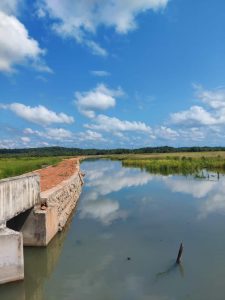
Photo Credit: Mohini Mehta
Due to its proximity to the merging point of a river and the sea, the Kaipad tract experiences flooding during the monsoon season and salinity during summer. The ecosystem comprises marshes, swamps, ponds, and paddy fields, which effectively control sedimentation, floods, and pollution. In addition to river water, the Kaipad fields benefit from the deposit of highly fertile organic matter derived from forest and marine waste. The combination of forest waste, marine waste, paddy stubble, bird excretions, and remnants from aquaculture contribute to the exceptional fertility of the Kaipad ecosystem. Consequently, the rice produced within this unique ecosystem is considered purely organic, reflecting its natural and sustainable cultivation methods.
Rice Farming and Aquaculture in Kaipad: A Natural Symbiosis
In the unique Kaipad ecosystems, the rice farming and aquaculture practices intertwine in a harmonious manner. Rice cultivation follows a natural and distinctive approach, relying on the monsoon season and the ebb and flow of the sea tides. Typically, a single crop of rice is cultivated on mounds within the low to medium saline phase of the production cycle, which occurs from June to October. The rice is usually ready for harvest by the end of October.
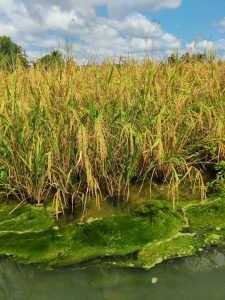
Photo Credit: Mohini Mehta
Following the rice harvest, the focus shifts to traditional fishing activities during the high saline phase, which extends from November to April. It is important to note that no chemical fertilizers or plant protection chemicals are utilized in either rice farming or fish and shrimp farming within the Kaipad ecosystem. The tidal flows play a pivotal role in enhancing the fertility of the fields through a symbiotic relationship between the rice crop and various aquatic creatures such as prawns, shrimp, and fish. After the rice harvest, fingerlings of these marine species enter the fields from the sea and backwaters, where they feed on the remnants of the harvested crop. In return, these sea creatures contribute their excrement and other remnants, providing vital nutrients for the rice crop.
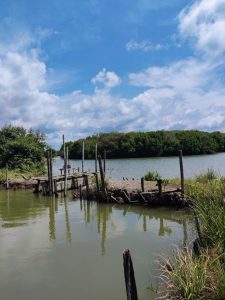
Photo Credit: Mohini Mehta
Additionally, it is interesting to observe the aquaculture practices in Kaipad after the paddy harvest. The fields are utilized for shrimp farming, employing traditional methods. Using sluice gates as a fish filtration system, fingerlings are captured during high tide and subsequently nurtured in the fields for several months, where they feed on the remnants of aquaculture debris. Throughout the monsoon season, fish filtration persists, albeit with reduced catch rates. This intricate blend of rice farming and aquaculture exemplifies the sustainable and traditional practices employed within the Kaipad ecosystem, showcasing a unique and mutually beneficial relationship between agriculture and the natural environment.
Why is the Kaipad Ecosystem Significant?
The detrimental effects of salt on agriculture are widespread, affecting around half of the world’s farms. To unlock the potential of salt-affected areas that are currently underutilized, improving the salt tolerance of major crops is the most practical solution. Since rice is a crucial food crop, developing new varieties with enhanced salt stress-tolerance would significantly boost global food production. However, there is a lack of research on breeding rice varieties tolerant to soil salinity.
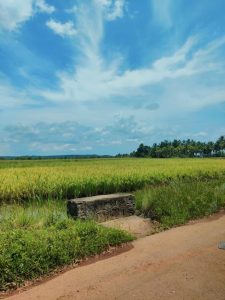
Photo Credit: Mohini Mehta
Amidst the challenges posed by climate change, including extreme weather events and rising sea levels, the Kaipad ecosystem assumes heightened significance. This ecosystem not only mitigates climate change but also safeguards traditional rice germplasm, farming knowledge, mangroves, aquaculture, biodiversity, and migratory birds. Protecting and developing the Kaipad system is an important matter. Moreover, with the growing focus on enhancing the smallholder agriculture sector, the Kaipad tract, governed by small and marginal farmers, has become increasingly vital.
Despite its inherent organic qualities, insufficient efforts have been made to safeguard the ecosystem, expand cultivation areas, and promote organic rice in the market. This neglect is worrisome, considering the critical role played by the Kaipad system in supporting smallholder farmers in the densely populated coastal region of North Kerala. Each hectare of Kaipad field has the potential to provide employment for over four thousand laborers annually. However, the Kaipad field is witnessing a rapid decline. However, by focusing on the Kaipad ecosystem, we can effectively address concerns related to food security, nutritional security, and uplift the living standards of small and marginal farmers.
The Role of the Malabar Kaipad Farmers’ Society and Dr. Vanaja T.
In 2010, the Malabar Kaipad Farmers’ Society was officially established as part of the RKVY paddy mission project. Dr. Vanaja T., the North Zone Associate Director of Research of Kerala Agricultural University and the Director of the Government of Kerala’s Kaipad Agency, led the establishment. The Malabar Kaipad Farmer’s Society plays a crucial role in supporting and advancing the interests of Kaipad Rice Farmers and Artisans. For the past decade, this society has been actively engaged in promoting the welfare of the Kaipad community. An important milestone for them was the acquisition of the Geographical Indication (GI) tag for their flagship product, Kaipad Rice, in 2014. Dr. Vanaja T., played a crucial role in securing the Geographical Indication tag for Kaipad rice. This recognition, similar to a patent, ensures the rice’s authenticity and distinctiveness.
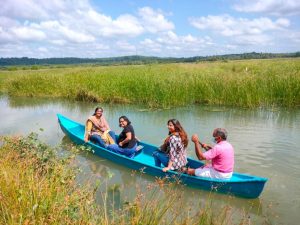
In recent years, the Regional Agricultural Research Station at Pilicode in Kasaragod, Kerala, developed a new rice variety named Mithila. Dr. Vanaja T. contributed by developing and releasing five high yielding saline tolerant rice varieties, namely ‘Ezhome -1’, ‘Ezhome -2’, ‘Ezhome -3’, ‘Ezhome -4’, and Mithila, as a result of a 20-year-long variety development program based on organic plant breeding and farmer participation since 2000. What sets Mithila apart is its remarkable ability to yield well with minimal management within the organic ecosystem. Moreover, it is well-suited for both the acidic saline soil of the Kaipad tracts in north Kerala and the alkaline saline soil of the Pokkali tracts. Dr. Vanaja T. played a pivotal role as the principal investigator and principal breeder of this exceptional organic rice variety.
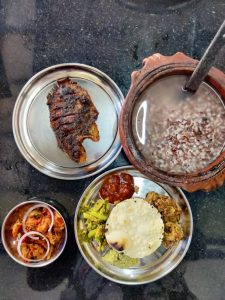
Photo Credit: Mohini Mehta
In conclusion, the Kaipad ecosystem in northern Kerala stands as a unique and remarkable example of integrated organic farming practices. With its saline-prone nature and the symbiotic relationship between rice farming and aquaculture, this ecosystem showcases a harmonious coexistence between agriculture and the natural environment. Efforts must be made to protect and develop this ecosystem, promote organic rice cultivation, and support the smallholder farmers who depend on it.